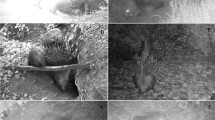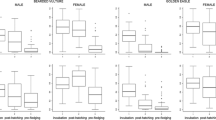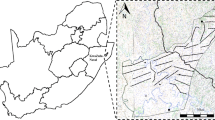Abstract
Old World porcupines are elusive, nocturnal rodents who pair for life, exhibiting frequent socio-sexual behaviour also outside the breeding period. Only anecdotal observations on captive individuals are available on the reproductive behaviour of the crested porcupine Hystrix cristata, a Sub-Saharan and North African large rodent probably introduced to Italy over 1500 years ago. Our work reports the first data on reproductive biology and paternal behaviour of free-living crested porcupines in Europe. A total of 44 litters was recorded at 4 den systems, over 3 years: 59% singletons, 32% twins, 9% triplets. Reproduction occurs throughout the year, but two significant birth peaks have been detected on February and October. The reproductive peak in October falls in the period of short rains in Sub-Saharan Africa, and coincides with the start of Autumn rains in Italy, thus preceding the vegetation regrowth in both areas, but especially in Africa. On the other hand, porcupines are unusual, as their “spring” peak of births in Central Italy falls actually in mid-winter (i.e. February), when snowfalls and the coldest temperatures tend to occur. By contrast, births in February anticipate the long rains in Sub-Saharan Africa by c. 30 days, when cubs leave the natal den for the first time and vegetation starts sprouting. Haphazard observations of cubs over 12 years (N = 72) have confirmed this pattern. Both partners (N = 2 radio-tagged pairs) share parental duties: alternation of cub guarding in den occurs in the first two months of life, i.e. when quills are still soft and relatively short, thus making cubs an easy prey for small and mesocarnivores.
Similar content being viewed by others
References
Agostinelli, C., 2009. CircStats: Circular Statistics, from Topics in Circular Statistics (2001). R Package Version 0., pp. 2–4, Available from: https://doi.org/CRAN.R-project.org/package=CircStats.
Ahmad, A., Chaudry, M.I., 1977. Studies on habits, habitat and damage of porcupines, Hystrix indica, Rodentia, Mammalia, Pak. J. For. 27, 147–150.
Amori, G., Contoli, L, Nappi, A., 2008. Mammalia II: Erinaceomorpha, Soricomorpha, Lagomorpha, Rodentia. In: Calderini (Ed.). Il Sole 24 Ore Edagricole, Bologna, Italy, pp. 694–706.
Angelici, F.M., Capizzi, D., Amori, G., Luiselli, L., 2003. Morphometric variation in the skulls of the crested porcupine Hystrix cristata from mainland Italy, Sicily and northern Africa, Mamm. Biol. 68, 165–173.
Armstrong, E.A., 1965. Bird Display and Behavior. Dover, Publisher, New York, USA.
Bartos, C, 2004. Husbandry Standards for Keeping Porcupines in Captivity. Baltimore Zoo Internal Publisher, Druid Hill Park, Baltimore, MD21217.
Batschelet, E., 1981. Circular Statistics in Biology. Academic Press, London, UK.
Barthelmess, E., 2006. Hystrix africaeaustralis, Mammalian species. Am. Soc. Mammol. 788, 1–7.
Bassano, B., Peracino, V., 1997. A robotized system for exploring mammal burrows, Wildl. Soc. Bull. 25, 98–100.
Bertolino, S., Colangelo, P., Mori, E., Capizzi, D., 2015. Good for management, not for conservation: an overview of research, conservation and management of Italian small mammals, Hystrix 26, 25–35.
Blanford, W.T., 1888. The Fauna of British India. Mammals. Taylor and Francis, London, UK.
Clay, Z., Zuberbühler, K., 2011. The structure of bonobo copulation calls during reproductive and non-reproductive sex, Ethology 117, 1158–1169.
Corsini, M.T., Lovari, S., Sonnino, S., 1995. Temporal activity patterns of crested porcupines Hystrix cristata, J. Zool. 236, 43–54.
Davis, L.S., 1982. Timing of nest relief and its effect on breeding success in Adelie penguins (Pygoscelis adeliae), Condor 84, 178–183.
Dewsbury, DA, 1985. Paternal behaviour in rodents, Am. Zool. 25, 841–852.
Ellenberg, H., 1988. Vegetation Ecology of Central Europe. Cambridge University Press, Cambridge, UK.
Felicioli, A., Santini, L, 1994. Burrow entrance hole orientation and first emergence time in the crested porcupine Hystrix cristata L: space-time dependence on sunset. Pol. Ecol. Stud. 3–4, 317–321.
Felicioli, A., Grazzini, A., Santini, L., 1997. The mounting and copulation behaviour of the crested porcupine Hystrix cristata, Ital. J. Zool. 64, 155–161.
Gaigher, I.G., Currie, M.H., 1979. Preliminary Studies on the Ecology of the Southern African Porcupine, Hystrix africaeaustralis. Department of Nature and Environmental Conservation, Province Administration of the Cape of Good Hope, South Africa, pp. 55–69.
Getz, L.L., Larson, CM., Lindstrom, K.A., 1992. Blarina brevicauda as a predator on nestling voles, J. Mammal. 73, 591–596.
Gosling, L.M., 1997. Reproduction of the Himalayan porcupine (Hystrix hodgsoni) in captivity, J. Zool. 152, 546–549.
Greaves, J.H., Khan, A.A., 1978. The status and control of porcupines, genus Hystrix as forest pests, Commonw. For. Rev. 57, 25–32.
Gubernick, D.J., Alberts, J.R., 1987. The biparental care system of the California mouse, Peromyscus californicus, J. Comp. Psychol. 101, 169–177.
Gubernick, D.J., Teferi, T., 2000. Adaptive significance of male parental care in a monogamous mammal, Proc. R. Soc. Lond. Ser. B 267, 147–150.
Khaliq, A., Khan, R.A., Yaqoob, S., Mejeed, A., 1991. Reproductive biology of the Indian crested porcupine, Pak.J. Agric. Res. 12, 71–73.
Kleiman, D.G., 1974. Patterns of behaviour in hystricomorph rodents, Symp. Zool. Soc. Lond. 34, 171–209.
Kleiman, D.G., 1977. Monogamy in mammals, Quarterly Rev. Biol. 52, 39–69.
Kleiman, D.G., Malcom, J.R., 1981. The evolution of male parental investment. In: Gubernick, D.J., Klopfer, P.H. (Eds.), Parental Cares in Mammals. Plenum, New York, pp. 347–387.
Lovari, S., Sforzi, A., Mori, E., 2013. Habitat richness affects home range size in a monogamous large rodent, Behav. Proc. 90, 42–46.
Lucherini, M., Lovari, S., Crema, G., 1995. Habitat use and ranging behaviour of the red fox (Vulpes vulpes) in a Mediterranean rural area: is shelter availability a key factor? J, Zool. Lond. 237, 577–591.
Masseti, M., Albarella, U., De Grossi Mazzorin, J., 2010. The crested porcupine Hystrix cristata L., 1758, in Italy, Anthropozoologica 45, 27–42.
McGuire, B., Bemis, W., 2007. Parental care. In: Wolff, J.O., Sherman, P.W. (Eds.), Rodent Societies: An Ecological and Evolutionary Perspective. The University of Chicago Press, Chicago, USA, pp. 231–242.
McGuire, B., Parker, E., Bemis, W.E., 2007. Sex differences: effects of male presence and coordination of nest visits in prairie voles (Microtus ochrogaster) during the immediate postnatal period, Am. Midl. Nat. 157, 187–201.
Massolo, A., Sforzi, A., Lovari, S., 2003. Chemical immobilization of crested porcupine with Tiletamine HCl and Zolazepam HCl (Zoletil®) under field condition, J. Wildl. Dis. 39, 727–731.
Mohr, E., 1965. In: Ziemsen Verlag, A., Wissenschaften, Westarp (Eds.), Altweltliche Stachelschweine. A. Ziemsen Verlag Publisher, Wittenburg Lutherstadt, Germany.
Morris, D.J., Van Aarde, R.J., 1985. Sexual behavior of the female porcupine, Hystrix africaeaustralis, Horm. Behav. 19, 400–412.
Mori, E., 2013. Spatial Behaviour of the Crested Porcupine Hystrix cristata L., 1758 in Contrasting Ecological Contexts. Ph. D. Dissertation in Evolutionary Biology, XXVI, Cycle. University of Siena, Italy.
Mori, E., Lovari, S., 2014. Sexual size monomorphism in the crested porcupine (Hystrix cristata), Mammal. Biol. 79, 157–160.
Mori, E., Nourisson, D.H., Lovari, S., Romeo, G., Sforzi, A., 2014a. Self-defence may not be enough: moonlight avoidance in a large, spiny rodent. J. Zool. Lond. 294, 31–40.
Mori, E., Lovari, S., Sforzi, A., Romeo, G., Pisani, C, Massolo, A., Fattorini, L., 2014b. Patterns of spatial overlap in a monogamous large rodent the crested porcupine. Behav. Proc. 107, 112–118.
Mori, E., Maggini, I., Menchetti, M., 2014c. When quills kill: the defense strategy of the crested porcupine Hystrix cristata L., 1758. Mammalia 78, 229–234.
Mori, E., Menchetti, M., Balestrieri, A., 2014d. Interspecific den sharing: a study on European badger setts using camera traps. Acta Ethol. 28, 121–126.
Mori, E., Sforzi, A., Menchetti, M., Mazza, G., Lovari, S., Pisanu, B., 2015. Ectoparasite load in the crested porcupine Hystrix cristata Linnaeus, 1758 in Central Italy, Parasitol. Res. 114, 2223–2229.
Patris, B., Baudoin, C, 2000. A comparative study of parental care between two rodent species: implications for the mating system in the mound-builiding mouse Mus spicilegus, Behav. Proc. 51, 35–43.
Pedro de Margalhães, J., 2011. Species selection in comparative studies of aging and antiaging research. In: Conn, P.M. (Ed.), Handbook of Models for Human Aging. Academic Press, New York, pp. 9–20.
Pettorelli, N., Pelletier, F., Von Hardenberg, A., Festa-Bianchet, M., Côté, S.D., 2007. Early onset of vegetation growth vs, rapid green-up: impacts on juvenile mountain ungulates. Ecology 88, 381–390.
Pigozzi, G., 1988. Quill-marking, a method to identify crested porcupines individually, Acta Theriol. 33, 138–142.
Santini, L., 1980. The habits and influence on the environment of the old world porcupine Hystrix cristata L. in the northernmost part of its range. Vertebrate Pest Conf. Proc. Collection, 149–153.
Schaller, G.B., 1972. The Serengeti lion: a study of predator-prey relations. University of Chicago Press, Chicago, USA.
Sever, Z., 1985. Studies on the Biology of the Indian Crested Porcupine (Hystrix indica) in the Coastal Plain of Israel. M.Sc. Thesis. George S. Wise Faculty of Life Sciences, Department of Zoology, Tel-Aviv University, Israel.
Sever, Z., 1991. Communication Patterns in Porcupines. Ph. D. Thesis. George S.Wise Faculty of Life Sciences, Department of Zoology, Tel-Aviv University, Israel.
Sever, Z., 2003. Constitutive fratricide in porcupines, Isr. J. Zool. 49, 86–87.
Sever, Z., Mendelssohn, H., 1985. Home range and movement patterns of the Indian crested porcupine (Hystrix indica) in the Coastal plain of Israel, Isr. J. Zool 33, 117–118.
Sever, Z., Mendelssohn, H., 1988. Copulation as a possible mechanism to maintain monogamy in porcupines, Hystrix indica, Anim. Behav. 36, 1541–1542.
Sever, Z., Mendelssohn, H., 1989. Scent marking behavior of porcupines, Isr. J. Zool. 36, 53–54.
Skinner, J.D., Van Aarde, R.J., VanJarsveeld, A.S., 1984. Adaptations in three species of large mammals (Antidorcas marsupialis, Hystrix africaeaustralis, Hyaena brunnea) to arid environments, South Afr. J. Zool. 19, 82–86.
Smithers, R.H.N., 1983. The Mammals of the Southern African Subregion. University of Pretoria, Pretoria, South Africa.
Syrůčkovà, A., Saveljev, A.P., Frosch, C, Durka, C, Savelyev, A.A., Munclinger, P., 2015. Genetic relationships within colonies suggest genetic monogamy in the Eurasian beaver (Castor fiber), Mamm. Res. 60, 139–147.
Taylor, K.D., Green, M.G., 1976. The influence of rainfall on diet and reproduction in four African rodent species, J. Zool. Lond. 180, 367–389.
Tohmè, G., Tohmè, H., 1980. Contribution à l’ètude du porc-èpic Hystrix indica indica Kerr, 1792 (Rodentia), Mammalia 44, 523–529.
Trivers, R.L., 1972. Parental investment and sexual selection. In: Campbell, B. (Ed.), Sexual Selection and the Descent of Man. Aldine Publishing, Chicago, pp. 136–179.
Trucchi, E., Sbordoni, V., 2009. Unveiling an ancient biological invasion: molecular analysis of an old European alien, the crested porcupine (Hystrix cristata). BMC Evol. Biol. 9, 109.
Trucchi, E., Facon, B., Gratton, P., Mori, E., Stenseth, N.C., Jentoft, S., 2016. Long live the alien: is high genetic diversity a pivotal aspect of crested porcupine (Hystrix cristata) long-lasting and successful invasion? Mol. Ecol., in press.
Van Aarde, R.J., 1985. Reproduction in captive female Cape porcupines (Hystrix africaeaustralis), J. Reprod. Fertil. 75, 577–582.
Van Aarde, R.J., 1987. Demography of a Cape porcupine Hystrix africaeaustralis population, J. Zool. Lond. 213, 205–212.
Van Aarde, R.J., Skinner, J.D., 1986. Reproductive biology of the male Cape porcupine, Hystrix africaeaustralis, J. Reprod. Fertil. 76, 545–552.
Van Aarde, R.J., Van Wyk, V., 1991. Reproductive inhibition in the Cape porcupine Hystrix africaeaustralis, J. Reprod. Fertil. 92, 13–19.
Weir, B.J., 1974. Reproductive characteristics of Hystricomorph rodents, Symp. Zool. Soc. Lond. 34, 265–301.
Wittenberger, J.F., Tilson, R.L., 1980. The evolution of monogamy: hypotheses and evidence, Annu. Rev. Ecol. Syst. 11, 197–232.
Wrangham, R.W., 1996. The sexual behaviour of chimpanzees and bonobos, our closest living relatives: multiple matings and multiple meanings, Glob. Bioeth. 9, 11–29.
Wuensch, K.L., 1985. Effects of early paternal presence upon nonhuman offsprings’ development, Am. Zool. 25, 911–922.
Author information
Authors and Affiliations
Corresponding author
Rights and permissions
About this article
Cite this article
Mori, E., Menchetti, M., Lucherini, M. et al. Timing of reproduction and paternal cares in the crested porcupine. Mamm Biol 81, 345–349 (2016). https://doi.org/10.1016/j.mambio.2016.03.004
Received:
Accepted:
Published:
Issue Date:
DOI: https://doi.org/10.1016/j.mambio.2016.03.004




